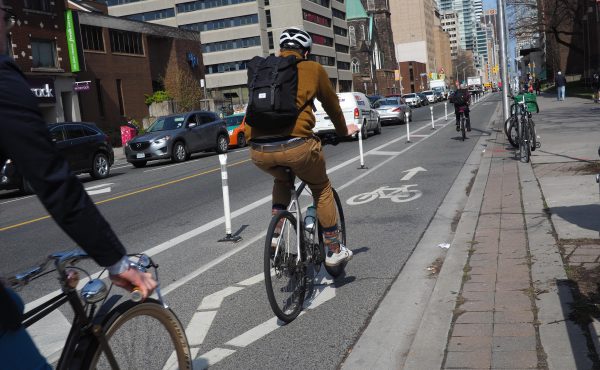
Every Tuesday, Todd Irvine of Local Enhancement and Appreciation of Forests (LEAF) will post a stop from the Toronto Tree Tours, a collaborative project of LEAF and the Toronto Public Space Committee. The Toronto Tree Tours offers walking tours in neighbourhoods across the city as well as virtual tours on its web site. The aim is to introduce Torontonians to the individual trees in their neighbourhood while telling stories of our city’s ecological and cultural history.
– – – – – – – – – – – – – – – – –
Trinity Bellwoods Tour: Stop 2
This property at the corner of Dundas Street and Shaw Street is Bellwoods Park House, which is owned by a not-for-profit organization that provides support services and independent living opportunities for people with physical disabilities. The building at the north end of the property includes 32 fully accessible rent-geared-to-income apartments. Well-treed grounds of mowed grass and flowerbeds fronted this building until 2006 when construction began on a new apartment building that will face Dundas Street. A portion of the large expanse of green space is to be lost as a result, and several of the trees had to be cut down.
On first blush, it is easy to deride this as another example of bad development stamping out the last remnants of green in the city. But the new building will be home to another 31 fully accessible apartments where people with physical disabilities will be provided the services necessary to live a healthy life integrated into the community.
While trees were lost, many others were saved, such as the three honey locusts (Gleditisia triacanthos) at the south east corner of the property and the row of Schwedler Norway maples (Acer platanoides “Schwedler”) lining the west side of Shaw Street. Fencing has been erected around the trees to keep construction equipment back from their branches and off their delicate roots, which will be easily damaged if the soil is disturbed. These trees would likely have been cut down as well if not for the City’s Private Tree Bylaw, which protects trees over 30 cm diameter on private property from being removed without permission.
Another positive component of the project is that an open tract of land crossing the property between the two buildings has been provided an easement, meaning that it will become an open green space with trees and landscaping that is publicly accessible during daylight hours. The easement follows the route of the buried Garrison creek and creates a natural linkage between Roxton Parkette to the northwest and Trinity Bellwoods Park to the southeast. With Toronto’s ever-growing population, development is inevitable. This project demonstrates that with thoughtful planning, density can be increased while also respecting existing natural features.
Upcoming tour: Parkdale Neighbourhood
When: Wednesday (tomorrow) August, 22 @ 7:00pm
Where: Masaryk-Cowan Community Recreation Centre
If you plan to attend please RSVP.
Photo by Liz Forsberg.




4 comments
Has anybody else noticed how people treat the areas inside these kinds of tree fences as giant trash containers?
David > yes, I have noticed this as well, its kind of like when I leave my bike locked up on a busy street and return to find garbage in my basket. Still, I would prefer litter on the ground inside these protection areas over the damaging effects of construction trucks and equipment.
“Several trees had to be cut down…”
But that’s okay, because there were a few we didn’t cut down…
V. Barch >
I appreciate your sarcasm, but I would ask, do you live in a building or a house? Do you ever go inside buildings for work, leisure or to shop? Have you ever travelled on a road or sidewalk? If so, you are complicit in the cutting down of literally hundreds of thousands of trees. At one time Toronto was covered by a forest. All the trees were cut down to build what we live in today.
The property in my post had trees on it that were planted by the owner 30 years ago. The organization that owns the site is creating a really valuable space that is going to help a lot of people, and they are going to plant many trees when they are done.
Other than sarcasm, do you have any suggestions how Toronto can accomodate the many people that are moving here each month without at times cutting down 30 year old landscape trees?
I would love to hear your thoughts.